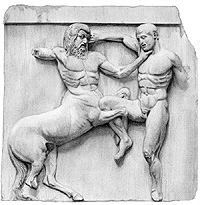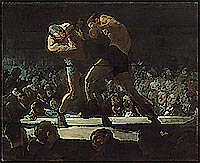Born out by the half-assed and good-hearted experiment in the video, is the fact that the sword originated as the complimenting weapon of the shield. One needed a spear and shield to fend off horsemen who were throwing darts and making overhand stabs with lances. However, in hand-to-hand combat the sword paired much better with the shield than the spear, as evidenced by the primacy of the roman swordsman over the Greek spearman [though not necessarily in mass combat]. Even among the Greeks the sword paired better with the shield as evidenced by the first documented battle of the hoplite age in the 7th century B.C. being fought on the island of Euobea with swords. Also, the advantage of Iphicrates’s peltasts [which were as much light hoplites as heavy peltasts] over the Spartans in the late 5th century B.C. on Spactria, although it is attributed to the peltasts being more lightly armed, may have had as much to do with their much larger swords. This match up, a small sword and large shield versus a large sword and small-to medium shield was the classic contest of the Roman gladiatorial rites, with some spectators being habitual followers of “the small shields” or “the heavy shields.”
Two things not addressed satisfactorily in this is the use of the spear in the overhand grip. This grip was used when on horseback, when elevated above the enemy—let us say up hill—and when shields locked and spears could not be handles around the body of the shield but either had to stab over or under. A formation using smaller shields like the Macedonian phalanx could stab under and around with the strongest grip, which is the upward underhand thrust, not the downward overhand thrust. The underhanded stab with a spear from behind a shield is much better than the same stab with a sword, which brings the sword hand forward of the shield and exposes it to being crushed by the shield rim of the opponent. Do note that light spears were sometimes thrown underhanded from under a shield. The hoplomachia, or the dance of the hoplite, included underhand and overhand grips with the hoplite being practiced in switching grips by letting go and re-grabbing the shaft.
Finally, the hand guard or hilt of a sword was originally designed to protect the hand from a shield smash and to permit the sword hand to slide round and stab under, around and over his own shield without getting caught on his own shield rim, which limited swords of the ancient type to simple handguards, not extended crosspieces. Eventually the cup or basket hilt would be developed by Spanish, Italian and Scottish armorers to compliment the use of medium-sized shields such as the targe. Ironically, the naval cutlass, designed for use in a sheildless setting, is probably the sword best suited for parring with the medium-sized round shield.
As pointed out by one of the enthusiasts in this video, the combatant must understand that is own shield generates a blind spot.
All Power Fighting
A Fighter's View of Mixed Martial Arts from Achilles to Alexander (The Broken Dance) (Volume 3)











La lance Chinoise youtube.com/watch?v=AVvGMHS5HYU